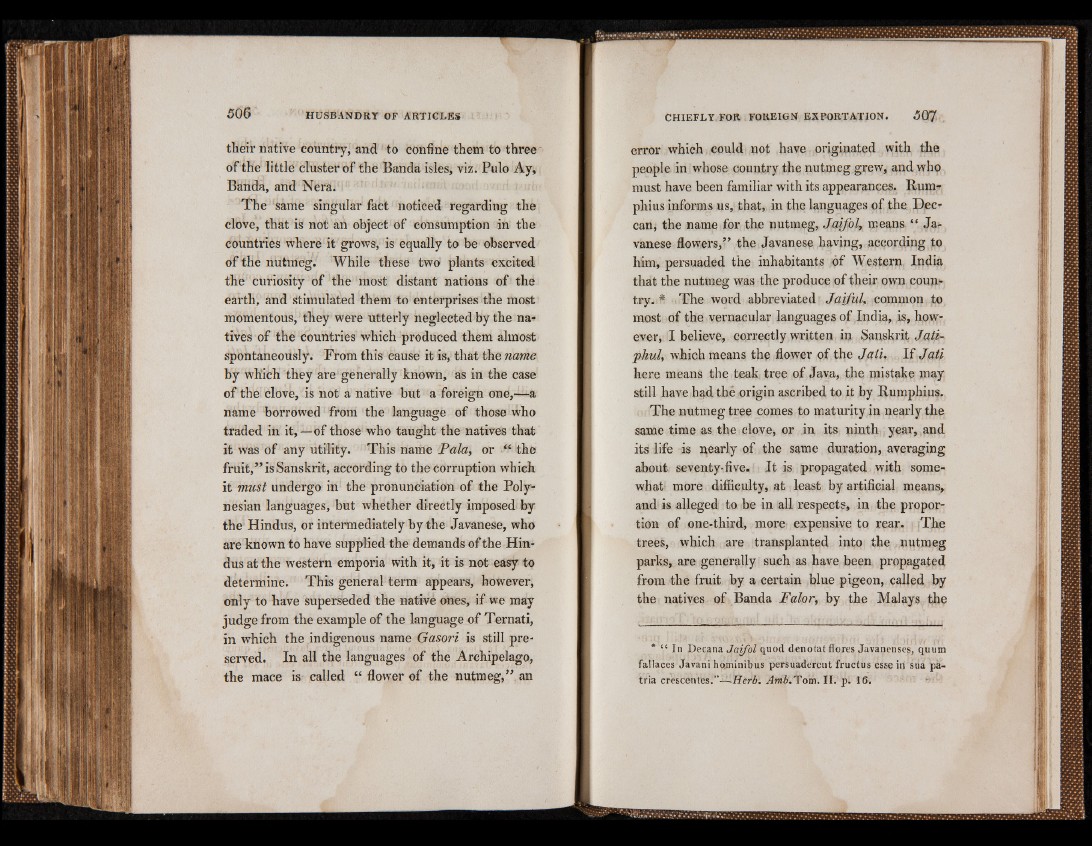
their native country, and to confine them to three
of the little cluster of the Banda isles, viz. Pulo Ay,
Banda, and Nera.
The same singular fact noticed regarding the
clove, that is not an object of consumption in the
countries where it grows, is equally to be observed
of the nutmeg. While these two plants excited
the curiosity of the most distant nations of the
earth, and Stimulated them to enterprises the most
momentous, they were utterly neglected by the natives
of the countries which produced them almost
spontaneously. From this eause it is, that the name
by which they are generally known, as in the case
of the clove, is not a native but a foreign one,—a
name borrowed from the language of those who
traded in it,—of those who taught the natives that
it was of any utility. This name Pala, or “ the
fruit,” is Sanskrit, according to the corruption which
it must undergo in the pronunciation of the Polynesian
languages, but whether directly imposed by
the Hindus, or intermediately by the Javanese, who
are known to have supplied the demands of the Hindus
at the western emporia with it, it is not easy to
determine. This general term appears, however,
only to have superseded the native ones, if we may
judge from the example of the language of Ternati,
in which the indigenous name Gasori is still preserved.
In all the languages of the Archipelago,
the mace is called “ flower of the nutmeg,” an
error which could not have originated with the
people in whose country the nutmeg grew, and who
must have been familiar with its appearances. Rum-
phius informs us, that, in the languages of the Dec-
can, the name for the nutmeg, Jaifol, means “ Jar
vanese flowers,” the Javanese having, according to
him, persuaded the inhabitants of Western India
that the nutmeg was the produce of their own country.
* The word abbreviated Jaiful, common to
most of the vernacular languages of India, is, however,
I believe, correctly written in Sanskrit Jati-
phul, which means the flower of the Jati, If Jati
here means the teak tree of Java, the mistake may
still have had thé origin ascribed to it by Rumphius.
The nutmeg tree comes to maturity in nearly the
same time as the clove, or in its ninth year, and
its life is nearly of the same duration, averaging
about seventy-five. It is propagated with somewhat
more difficulty, at least by artificial means,
and is alleged to be in all respects, in the proportion
of one-third, more expensive to rear. ¡The
trees, which are transplanted into the nutmeg
parks, are generally such as have been propagated
from the fruit by a certain blue pigeon, called by
the natives of Banda Falor, by the Malays the
* “ In Decana Jaifol quod dénotât flores Jaranenses, quum
fallaces Javani hqminibus persuadèrent fructus esse in sua pà-
tria crescentes.”-i-;-iîer5. Amb. Torn. II. p. 16.